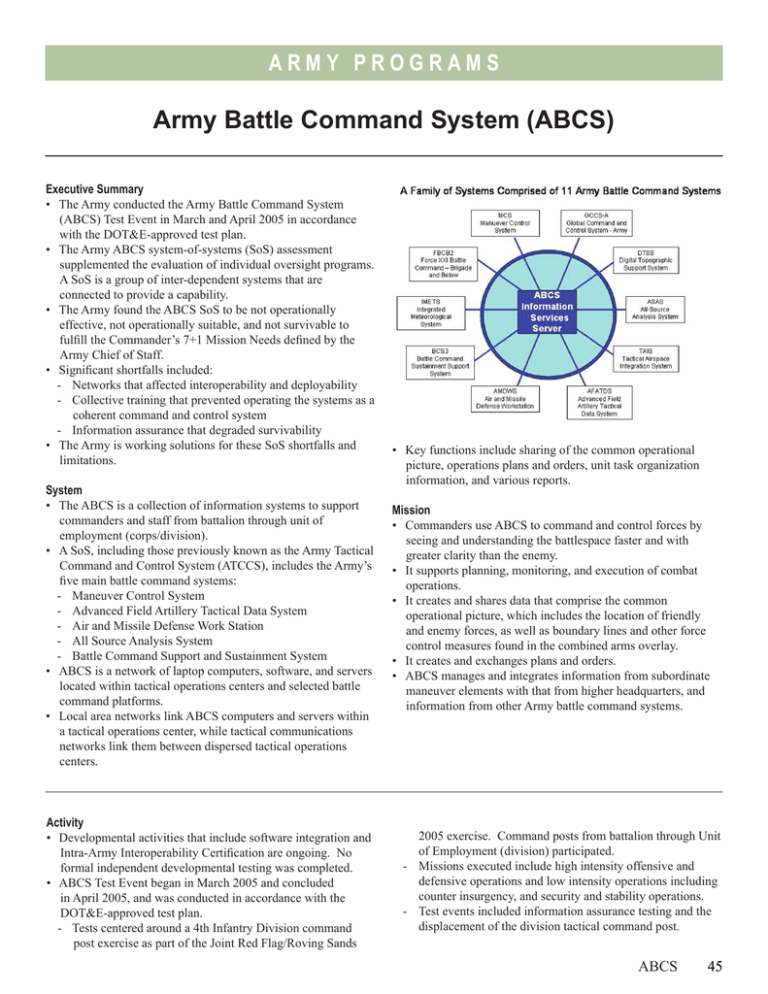Army Battle Command System (ABCS)
advertisement

ARMY PROGRAMS Army Battle Command System (ABCS) Executive Summary • The Army conducted the Army Battle Command System (ABCS) Test Event in March and April 2005 in accordance with the DOT&E-approved test plan. • The Army ABCS system-of-systems (SoS) assessment supplemented the evaluation of individual oversight programs. A SoS is a group of inter-dependent systems that are connected to provide a capability. • The Army found the ABCS SoS to be not operationally effective, not operationally suitable, and not survivable to fulfill the Commander’s 7+1 Mission Needs defined by the Army Chief of Staff. • Significant shortfalls included: - Networks that affected interoperability and deployability - Collective training that prevented operating the systems as a coherent command and control system - Information assurance that degraded survivability • The Army is working solutions for these SoS shortfalls and limitations. System • The ABCS is a collection of information systems to support commanders and staff from battalion through unit of employment (corps/division). • A SoS, including those previously known as the Army Tactical Command and Control System (ATCCS), includes the Army’s five main battle command systems: - Maneuver Control System - Advanced Field Artillery Tactical Data System - Air and Missile Defense Work Station - All Source Analysis System - Battle Command Support and Sustainment System • ABCS is a network of laptop computers, software, and servers located within tactical operations centers and selected battle command platforms. • Local area networks link ABCS computers and servers within a tactical operations center, while tactical communications networks link them between dispersed tactical operations centers. Activity • Developmental activities that include software integration and Intra-Army Interoperability Certification are ongoing. No formal independent developmental testing was completed. • ABCS Test Event began in March 2005 and concluded in April 2005, and was conducted in accordance with the DOT&E-approved test plan. - Tests centered around a 4th Infantry Division command post exercise as part of the Joint Red Flag/Roving Sands • Key functions include sharing of the common operational picture, operations plans and orders, unit task organization information, and various reports. Mission • Commanders use ABCS to command and control forces by seeing and understanding the battlespace faster and with greater clarity than the enemy. • It supports planning, monitoring, and execution of combat operations. • It creates and shares data that comprise the common operational picture, which includes the location of friendly and enemy forces, as well as boundary lines and other force control measures found in the combined arms overlay. • It creates and exchanges plans and orders. • ABCS manages and integrates information from subordinate maneuver elements with that from higher headquarters, and information from other Army battle command systems. 2005 exercise. Command posts from battalion through Unit of Employment (division) participated. - Missions executed include high intensity offensive and defensive operations and low intensity operations including counter insurgency, and security and stability operations. - Test events included information assurance testing and the displacement of the division tactical command post. ABCS 45 ARMY PROGRAMS • Follow-on testing occurred in August and September 2005 in conjunction with other 4th Infantry Division training events at Fort Hood, Texas, and the National Training Center in California. Assessment • This was the first attempt to test and assess the operational effectiveness, suitability, and survivability of a SoS or Family of Systems (FoS). The component systems within ABCS were developed separately and up to this point were considered a FoS (i.e., they operated independently within their own battlefield functional areas). Information provided by each component was integrated by the operations staff within the command elements. However, with the horizontal integration of these systems at the command level, they are now viewed as a SoS. A SoS is a group of independent systems that are connected to provide a capability. The loss of any part of that SoS degrades the capability provided by the integrated whole (i.e., the whole is now greater than the sum of the parts). • There is no formal ABCS capabilities document to guide the assessment. Instead, the assessment looked at the ability of ABCS to satisfy the Commander’s 7+1 Mission Needs. • These mission needs were reported to the Chief of Staff of the Army from commanders in the field. They include friendly locations, current enemy situation, running estimate, graphics and overlays, plans and orders, commander’s situation report, fire support coordination measures/overlays, and Joint and coalition interoperability. • The ABCS test event was also an IOT&E for the Maneuver Control System and All Source Analysis System Block II systems. The test provided data to support software material release decisions for the Air and Missile Defense Work Station, the Advanced Field Artillery Tactical Data System, and the Battle Command Support and Sustainment System. • The assessment determined that the ABCS SoS was not operationally effective, suitable, or survivable. Significant observations contributing to the conclusions include: - Inflexible networking products complicate, and often prevent, altering the ABCS architecture to match the unit’s operational architecture. The products themselves are inflexible and the process to create the products is too complicated and time consuming to respond to dynamic operations. 46 ABCS - The training program does not prepare the unit to employ the ABCS as an integrated and comprehensive command and control system; this includes how systems integrate with one another to support battle staff operations. Sustainment training did not maintain operator proficiency nor provide opportunity to train new soldiers arriving in the unit between new equipment training and conduct of the test event. - Interoperability challenges include time to process overlays and database updates, incompatible graphics types and formats, and the reliability of the ABCS Information Services server. - Information assurance vulnerabilities were identified and exploited. These ABCS SoS issues affect multiple systems. The performance of each individual system in the ABCS is inextricably tied to the performance of the SoS network that defines the information flows and links the systems to one another. Correction of these issues is beyond the scope of the individual acquisition programs, but is required for the individual systems and overall ABCS to provide its required capability. The ABCS SoS assessment contributed valuable insights to the evaluations of the individual acquisition programs. By taking a more holistic approach, the assessment identified significant issues beyond the scope of a single program manager’s responsibility. This assessment and subsequent recommendations were briefed to the Chief of Staff of the Army. These cross-cutting issues are as important to warfighting effectiveness as specific deficiencies associated with the individual programs. Recommendations 1. Develop improved networking products to support dynamic and flexible operations. 2. Demonstrate corrections to information assurance deficiencies. 3. Create and fund improved collective and sustainment training programs to increase utility to the warfighter.







